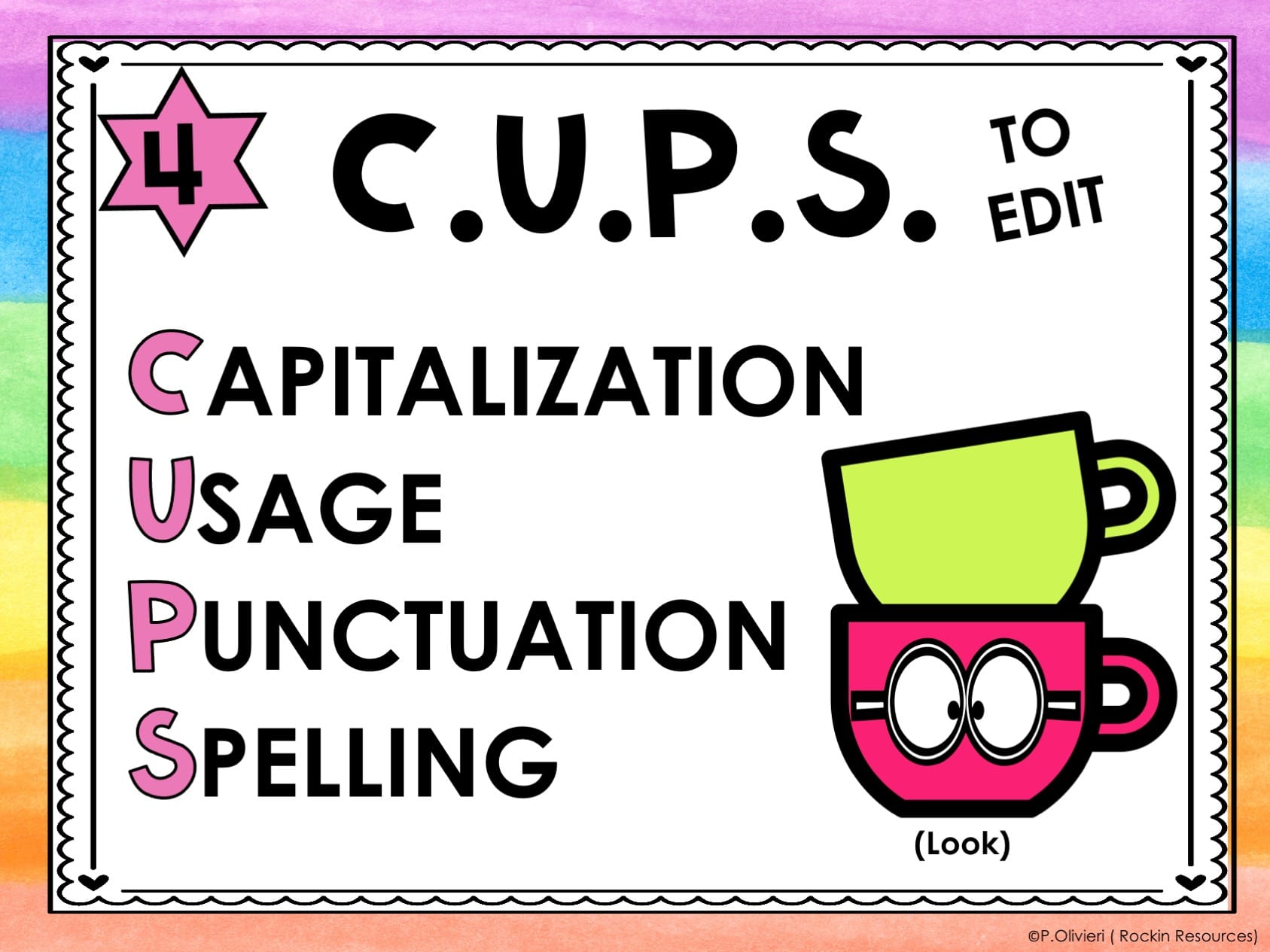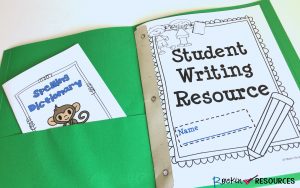If you are looking for ideas in the editing step of the writing process, you are in the right place! This post will provide ways to teach and break down different editing techniques. Although it is part of a series of 30+ writing mini lessons on narrative writing, it can also be used in other types of writing like opinion writing and informative writing.
For this step of the writing process, you will spend several days teaching mini lessons for each letter in CUPS.
1. TEACH
When in the revising stage, we “listened” for the errors. With CUPS, we “look” for errors. Get out those magnifying glasses! Oh yeah! Use magnifying glasses in class to support this step of the writing process. The first mini lesson is introducing CUPS. This acronym will be used all year when editing any writing throughout the year. WHAT IS CUPS?
Grab the writing process posters for FREE HERE. The skills that should be covered for Grades 3-5 are the following:
Capitals– beginning of the sentence, I, proper nouns, titles, inside quotes.
Usage– subject-verb agreement, double negatives, sentence fragments, run-on sentences, verb forms and tenses, pronoun case forms.
Punctuation– End of sentences, commas in a series, quotations, combine sentences
Spelling Rules–
1. Always put a u after a q. (quack, quiet)
2. Every syllable has a vowel.
3. The “soft” sound of c (s sound) or g (j sound) is usually foll0wed by i, y, or e. (city, gym)
4. Write I before e except after c or when sounded like a. (thief, believe, ceiling, receive, neighbor, weigh)
5. Spelling Rules for Adding Inflectional Endings to Words
- Most words- Add the ending. (talk- talked, talking)
- Words ending in a single vowel and consonant- Double the final consonant and add the ending. (stop- stopped, stopping)
- Words ending in silent e- Drop the e before adding the ending. (bake, baked, baking)
- Words end in a consonant and y- Change the y to and i then add the ending unless the ending is -ing. (hurry- hurried, hurrying)
- Words that end in ss, ch, sh, zz, or x: Add –es (foxes, wishes)
2. MENTOR TEXT
Choose a recent story that you read in class. Point out the corrent grade level capitalization, usage, punctuation and spelling.
3. MODEL
For CUPS, take your class rough draft and if you didn’t purposely make mistakes while writing it, go back and rewrite it using editing mistakes! Then use a different color pen than used for revising. If you used multiple colors by teaching FAAVS in revising, then choose a different color than the colors in FAAVS or allow students to use multiple colors. Use whatever it takes for students to be excited about editing! During the editing process, have a dictionary available! When modeling, use the dictionary to look up how to spell words! Also have student writing resources available either at the writing center, groups, or individual folders. Model yourself going through the resources to guide you in your editing! You can find a FREE SPELLING DICTIONARY in my store.
4. TAKE NOTES
Students should take notes on the steps of CUPS and also keep a separate folder for the student resources for CUPS.
5. PRACTICE
Practice will take place with each letter of CUPS in the following mini lessons.
6. APPLY
After all of the following mini lessons in CUPS, students should apply it to their own stories.
Follow the next 4 mini lessons for more ideas on CUPS!
Check out my FREE writing masterclass! CLICK HERE
LAST LESSON: WRITING MINI LESSON #31- CRAFTING A TITLE
NEXT LESSON: WRITING MINI LESSON #33- CUPS- C FOR CAPITALIZATION
CLICK HERE FOR THE FULL LIST OF WRITING MINI LESSONS
This lesson is also included in the STEP-BY-STEP WRITING® Program with mini-lessons designed to scaffold through the writing process. Writing units included are sentence structure, paragraph writing, narrative writing, opinion writing, and informative writing. See what is included in the image below and click on it to learn more about them! You will turn your reluctant writers into ROCKSTAR WRITERS™!
“You are an angel! Not only is this a spectacular resource but my students are constantly engaged. I’ve never used an interactive notebook type resource before and I am sold! The children are learning without realising it and I have never had such success with narrative writing across so many students. I am pleasantly amazed. Looking forward to moving onto the other text types as the year progresses (calendar year in Australia). Thank you so much!” -Mrs. N.
ROCK ‘N’ WRITE!!!!!








